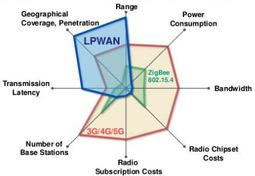
LoRa Wireless Technology: M2M and IoT Networks
Explore LoRa wireless technology basics, including frequency bands, protocol stack, MAC layer, and LoRaWAN classes for M2M and IoT networks.
Advertisement

Explore LoRa wireless technology basics, including frequency bands, protocol stack, MAC layer, and LoRaWAN classes for M2M and IoT networks.

Explanation of LoRaWAN data rates, EIRP transmit power, and frequency bands used in India. Includes information on LoRaWAN architecture and specifications.

Explore LoRaWAN device, service, and routing profiles. Understand their parameters and how they enable LoRaWAN radio access service and data plane connections.

Overview of LoRaWAN frequency bands, channels, data rates, and transmit power (EIRP) used in the European (EU) region for EU863-870 and EU433 bands.

Details of LoRaWAN frequency bands, channels, data rates, and transmit power used in Russia (RU864-870 band).

An overview of LoRaWAN frequency bands, data rates, and EIRP limits for the KR920-923 ISM band in Korea.

This article details LoRaWAN frequency bands, data rates, and EIRP used in China (CN region). Specifications vary based on the region.

Learn about LoRaWAN interface types (hNS-JS, vNS-JS, ED-NS, AS-hNS, hNS-sNS, sNS-fNS, AS-JS) and their roles in LoRaWAN network architecture.

A LoRaWAN packet forwarder relays data between end devices and the network server. It handles uplink transmission and downlink reception, crucial for LoRaWAN communication.

Explore the differences between LoRaWAN passive and handover roaming, focusing on network server control, frame forwarding, and MAC layer management.

Understand LoRaWAN spreading factor, range, and data rate. Explore the relationship between these terms, including formulas and regional data rate variations.

Explore the differences between LoRaWAN and Sigfox technologies for IoT networks, focusing on network architecture, data rates, and applications to help you choose the best solution.

Explore the pros and cons of LoRaWAN technology, covering its strengths in range, power consumption, and scalability, as well as its limitations in data rate and real-time use.

Learn the difference between implicit and explicit headers in LoRaWAN packets, including structure, information contained, and usage.

Explore the pros and cons of Low Power Wide Area Networks (LPWANs) for IoT, including range, power, cost, and limitations.

Explore LTE NB-IoT channel types, detailing the signals and channels used in both downlink and uplink communications for narrowband IoT.

Explore the pros and cons of Low Throughput Network (LTN) technology, ideal for M2M and IoT applications requiring long-range, low-power communication.

Explore the benefits and drawbacks of LWM2M (Lightweight Machine to Machine Communication). Understand its advantages and disadvantages for constrained IoT devices.

Explore the benefits and drawbacks of Machine-to-Machine (M2M) communication, including its architecture, advantages, and disadvantages in various network topologies.
Explore M2M (Machine to Machine) frequency bands utilized globally, including technologies and carriers in various countries, spanning 2G, 3G, and 4G networks.
Advertisement